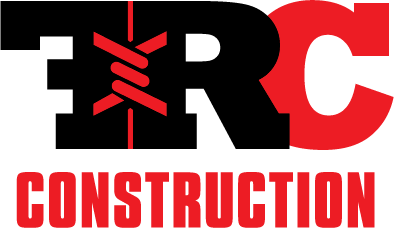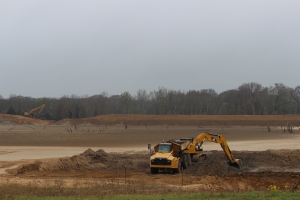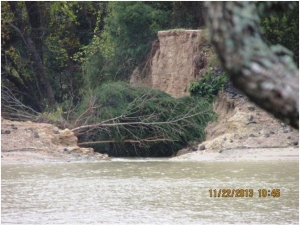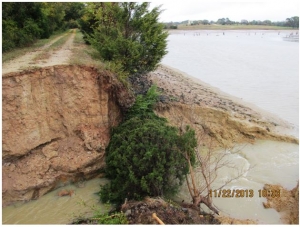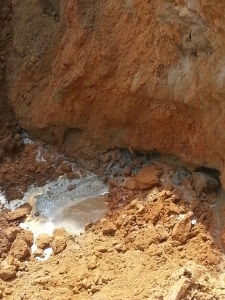Older Texas dams need maintenance. Time after time, we find older dams that have not been properly maintained. Most land owners aren’t properly informed as to what is necessary to care for a dam. Farm & Ranch Construction has recently completed the repair of the dam on Kennedy Lake in Limestone County, Texas.
Kennedy Lake, which covers approximately thirty-eight surface acres, was originally constructed over fifty years ago. The lake is privately owned, but shared with the community. It has provided a place for locals to fish and camp for many years. One night in November of 2013, the dam burst. In a matter of hours, this previously pristine water resource was reduced to an enormous mud pit.

Kennedy Lake (Groesbeck, Texas) : Finding the right kind of soil for the core led us to dig out parts of the lake bottom
As is the case on many older lakes, the Kennedy Lake Dam had become infested with a covering of brush and trees. In this instance, there were some very sizable trees on the back slope of the dam. This created an opportunity for piping to occur throughout the structure.
Piping is a problem that occurs when tree roots grow through the dam. (Piping as defined by the TCEQ, is “The progressive removal of soil particles from a dam by percolating water, leading to development of channels or flow paths.”) For whatever reason, the tree dies. Then the root of the tree rots away. This leaves a void or a weak spot in the structure of the dam. At the same time, burrowing animals such as Armadillos, Nutria, or Beavers will dig a hole in from the opposite side. The burrowing tunnels intersect with the rotted tree root voids, which completes a pipeline through the dam.
The Kennedy Lake disaster happened when the lake level rose very quickly during a flood event. The resulting column pressure was sufficient to force the water through a pipeline allowing the structure to collapse from within. Once the water began flowing through the pipeline, the hole gradually increased in size, eventually causing the complete failure of the structure.
Farm & Ranch Construction took several steps to repair the damage. First, we up-rooted all the trees and vegetation that had grown up on the dam surface. As you can see in the previous photos, there were some particularly large trees on the back side of the dam near the base. We had to make sure and grab the root ball in it’s entirety to be sure we had eradicated any organic substance that would possibly decompose and lead to piping. Then we de-watered what was left of the lake in order to give ourselves a drier surface to work on. This included digging an approximately twelve foot wide trench from the main watershed entry point all the way to the breach in the dam. The soil on the lake bottom, which to this point had held water like a sponge, emptied itself in the trench that had been dug across the lake. This allowed us to look for suitable soil in the lake basin for repairing the slopes and then later installing a core in the breach. We set ourselves to repairing the front and back slopes in eight inch lifts from the soil excavated from the lake bottom. We set the slopes at 3:1 on the front and 4:1 on the back according to the engineer’s specifications.
During the process of repairing the slopes we continued to find more evidence of piping. These discoveries led us to install a core throughout the majority of the dam. What was already a large project increased in size due to necessity. The last step we took was to re-fill and compact the breached area of the dam.
If you have an older dam on your property, it should be periodically be inspected by a qualified engineer. In the case of Kennedy Lake, Lindemann Engineering, located in Temple, Texas, was selected to survey the dam and the damage that had been caused by the piping and years of erosion. Dr. Lindemann wrote a scope of work for the repair, supervised the work during re-construction, and certified the dam after the repairs were completed.
If you think you might have an issue with your dam, please feel free to contact Farm & Ranch Construction for assistance. There is no charge for our initial visit to your property.
